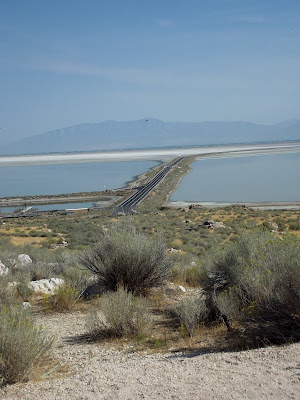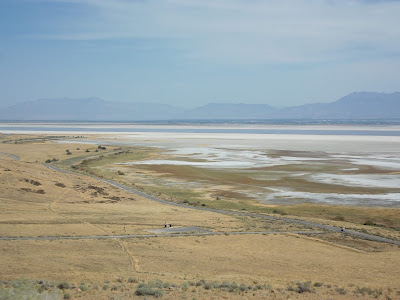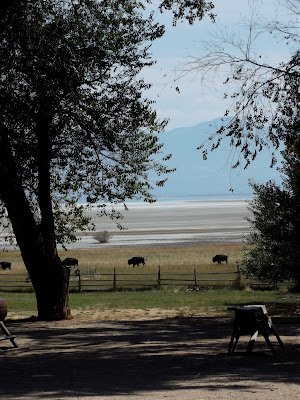Our
destination today was the Great Salt Lake and Antelope Island. Great Salt Lake is the largest natural lake
west of the Mississippi River. The lake
is a remnant of pre-historic Lake Bonneville.
On average
the lake is 75 miles long by 28 miles wide, covering 1,700 square miles. At this level, maximum depth is about 33
feet. Size and depth vary greatly with
seasonal evaporation and precipitation.
Water flows
into the Great Salt Lake from four rivers, however, the lake has no
outlet. Water leaves only through
evaporation, because of this, high concentrations of minerals are left
behind. It is at least 5 times saltier
than the ocean.
Salinity is
too high to support fish. Brine shrimp,
brine flies and several types of algae thrive in the lake and are primary food
sources for millions of migrating birds.
Brine shrimp
live 3 months and the adults are only ¼ inch long. The brine shrimp eggs or cysts are harvested
every year and sold worldwide for fish and prawn food.
There is a
$10 fee to get onto the seven mile long Davis County Causeway which is the only
way onto Antelope Island, the biggest island in the Great Salt Lake. On the causeway there is a very strong odor,
but we didn’t notice it throughout the rest of the park. It seemed rather caustic and I found it hard
to breathe.
The island
is 28,000 acres, 15 miles long and 4.5 miles wide. There are freshwater springs on the island
that support hundreds of animals – bison, pronghorn antelopes and others we
weren’t lucky enough to see.
The
visitor’s center tells more about the island and offers some great views.
Statues
along the walk up to the visitor’s center.
A view of
the causeway from the visitor’s center.
Views of the
surrounding area from the center.
Buffalo and
Pronghorn antelopes were grazing or running through the pasture near the
visitor’s center.
Views of the
lake and surrounding area. Since there
are no waves sometimes it is hard to tell where the lake ends and the sky
begins.
There is a
grill on the island. However, I don’t
think I would want to try to eat there, the flies would be overwhelming.
Mountains
run through the middle of the island.
The Fielding
Garr Ranch on the island was settled in 1848 by Fielding Garr and his six
children. Garr was a stonemason and
built several buildings including the farm house from adobe brick. In 1850 the Church of the Latter Day Saints
designated the island as a range for church cattle and sheep herds. Brigham Young pastured his animals here as
did many other prominent people from Utah.
Fielding Garr died in 1855. After
a series of other farm managers the church relinquished the island in 1875.
It wasn’t
until the 1950’s that some modern conveniences such as indoor plumbing and
electricity provided by a gas generator came to the island.
The island
fell to numerous corporate ownerships until 1981 when it was purchased by Utah
State Parks and Recreation.
Buffalo
grazing around the Fielding Garr Ranch.
Lots of
artifacts in the old barn.
David
Snider, this shouldn’t take too much work.
The adobe
brick ranch house is in the back ground.
The bunkhouse is to the right.
Laundry
area.
The record
player was manufactured in Richmond, IN.
Views
heading back.
Brine flies
swarm near the water. The larvae hatch
in the water along the shore creating a black band. We enjoyed the drive around the area but had
no desire to walk the distance it would have taken to actually get to the
water. Besides that we would have had to
fight the brine flies to get there (supposedly they don’t bite).































No comments:
Post a Comment